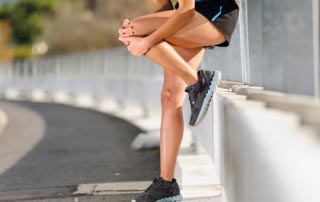
The anterior cruciate ligament (ACL) is one of four of the ligaments providing stability to the knee. ACL injuries are common amongst high school and collegiate athletes in high risk sports, ranging from sprains to complete ruptures. They generally occur during activities including changing direction while running, coming to an abrupt stop, improper landing upon jumping, and collisions during contact sports.
Girls especially are 4-6 times more prone to injury due to their unique anatomy and physiology(1):
- They have a wider pelvis making the angulation of the knee greater, contributing to excess tension on the ACL.
- The ACL in females is smaller, making it less resistant to tensile forces.
- Females do not have the testosterone that their male counterparts have, making their muscular system less supportive of their bones and joints with activities like running, jumping and cutting activities.
- Estrogen contributes to the increase in flexibility in ligaments and tendons.
- Other factors that contribute to ACL injury in both males and females include poor balance and flat arches.
What can you do to prevent injury?
- Make sure the field or area you are playing on is free of defects, like holes in the ground, rocks, etc.
- Obtain supportive foot wear or custom orthotics if needed to provide proper foot support.
- Train for your sport before playing. Many injuries occur from being a “weekend warrior”.
- Follow-up with a Physical Therapist for evaluation of strength, balance, running assessment and jump analysis and training. ACL injury risk is predictable and can even be prevented. (1)
I have an ACL injury, now what?
- Follow up with your primary care doctor and/or orthopedist for definitive diagnosis. A grade I ACL sprain is followed by Physical therapy for rehabilitation. A grade II will depend on how much of the tendon is torn, patient age, and level of activity of the patient is as to whether it will be repaired or allowed to heal. A grade III is a complete rupture and will be repaired by an Orthopaedic Surgeon if the patient is young and/or active.
- Ask your surgeon about doing Physical Therapy prior to surgery to control swelling and pain, restore ROM and strength which is vital for good outcomes, and prepare for surgery.
- Perform exercises like recumbent biking and restore ROM, especially straightening, as soon as possible. Both poor quadriceps control and inability to straighten the knee fully lead to unsatisfactory outcomes.
- After surgery, expect to be on crutches for a few days to weeks depending on whether there is a co-injury such as an MCL sprain, meniscus tear, or bone bruise. Always adhere to your surgeon’s precautions.
- Plan on refraining from contact sports for the next 9 months and complete jump training and sport specific plyometric training guided by a Physical Therapist before returning to sport to avoid re-injury.
(1.) Hewit, TK, Myer GD, Ford KR, Hiedt RS, Colosimo AJ, McLean SG, van den Bogert AJ, Paterno MV, and Succop P. Biomechanical Measures of Neuromuscular Control and Valgus Loading of the Knee Predict Anterior Cruciate Ligament Injury Risk in Female Athletes A Prospective Study